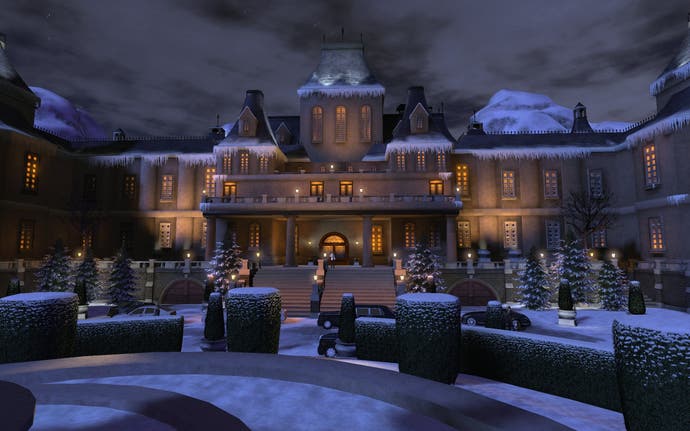The Agency
Spies like us.
Visit Sony Online Entertainment's Seattle offices, which house the team making its stylish espionage MMO The Agency for PC and PS3, and you get buried alive: in ideas, in raw information, in words. Most of these things are fired out of the mouth of lead designer Hal Milton at machine-gun rate and you're left frantically scribbling away to keep up, not to mention thrown by the propensity of Milton and the rest of the team to answer questions on almost any facet of the gameplay in great detail, rather than with a "we're not talking about that today".
As a consequence, we've got a lot to get through here, and we don't have much time. If you're unfamiliar with the basics of one of the most exciting and original online games in development, please check out our preview and interview from last year. In brief, and after a deep breath:
Two factions, super-spies UNITE and mercenaries Paragon; six equipment-defined roles in combat, stealth and support that can be switched at will on any character; a raft of pop-culture influences from Bond and Bourne to Alias and the A-team; alias outfits for disguise and infiltration gameplay; NPC operatives you can collect and trade like cards who can research and manufacture equipment or intel while you're offline, or provide support skills in combat; missions that scale to solo or group play; locations across the world, centred on Prague in Europe and Panama in Central America; squad-shooter dynamics, a balance of player skill and RPG progression, player-versus-player skirmishing, a strong storyline.
So what's new to this pre-E3 preview? Principally, a chance to see the game running live on both formats, SOE having previously only shown video footage. Two developers play through a mission (hosted on remote servers in San Diego), one on PS3 and one PC, proving that cross-platform play is technically possible, even if they've not decided for sure to include it for gameplay balance reasons and different strategies for updates. The game looks more or less identical across the formats, clean, sharp and colourful if not abundant in detail; the PS3 version seems to have a slower frame-rate at the moment, but we're promised an inviolable 30 frames a second come launch.

We're also introduced to a couple of new locations: UNITE's private airship, the Sophia II, and the Swiss château where the mission takes place. The Sophia II is a kind of mobile mission hub and social area that houses mini-games, a tank full of sharks (but of course), and docks at cities around the world. Like all zones in the game, it can also be used for mission encounters. SOE is looking to find a more flexible structure for the Agency than most MMOs, which tend to divide their zones into safe social areas, the open world and instanced encounters, each one immutable.
"We're trying to find a middle-ground between, say, Guild Wars and Phantasy Star Online over here, and EverQuest II and World of Warcraft over here; all public with some minor instancing, or all instancing with a couple of public hubs," says Milton. "We're thinking that we can kind of do a little bit of both. This friendly public space? Get used to it, explore it, learn all the nooks and crannies, because it could turn into a combat environment and that knowledge would be helpful."
Indeed, the opening moments for UNITE agents will place them on an "airship headed for disaster", while Paragon players will start their adventure checking out suspicious events on an oil rig for a client. No menial chores to do - The Agency offers globe-trotting high drama from the very beginning, and squeezing as much as it can out of its glamorous locations - we also hear mention of Kiev, Venice, Amsterdam, an island off the coast of Thailand, jungles in Central America - is a priority for a team that doesn't have the luxury of creating acres of open wilderness for players to explore.

"We have to have cities, and cities are complicated, there's a lot of stuff in a city. There's tons of detail," says art director Corey Dangel. "We'll have some locations that are epic; Kiev is a pretty big location in our world, Prague right now is actually super-frickin'-huge. In fact, it may be too big. It may actually have to get a little bit of a haircut." Prague is where you'll find the principal headquarters for your faction, but the world will also be dotted with field offices that serve as last-resort checkpoints.
Step into a mission, and you'll have to choose what to take with you from your collection of operatives, weapons, gadgets and outfits. You can equip two outfits for the field, one of the six "roles" or classes (combat, stealth or support), and your infiltration alias. Very high-level players will be able to get their operatives to craft aliases into role outfits to combine the two - so toting both a tuxedo and a machine-gun at the same time will be The Agency's bragging-rights equivalent of wearing fire-breathing dragon skulls on your shoulders and carrying a sword that's bigger than you are.
The Swiss château mission we see is one of The Agency's mixed-group missions, where the UNITE and Paragon plot threads converge. Using one agent from each, in evening-wear aliases, the developers move through a glossy cocktail party trying to keep their alias ratings intact, avoid the attentions of patrolling guards, cause distractions, gather intel and disable systems using the Paragon agents engineering skills and the UNITE agent's camera. It's an example of how traditionally solo stealth gameplay can be made to work in multiplayer, the players converging on a rendezvous, remotely helping each other get past certain obstacles on the way, in what SOE calls "Mission: Impossible" style.


.png?width=291&height=164&fit=crop&quality=80&format=jpg&auto=webp)




.jpg?width=291&height=164&fit=crop&quality=80&format=jpg&auto=webp)
